Acousto–Optic Modulation and Deflection of Terahertz Radiation
Abstract
:1. Introduction
2. Theoretical Background
2.1. THz Acousto–Optic Modulator
2.2. THz Acousto–Optic Deflector
3. Experimental Results and Discussion
4. Conclusions
Author Contributions
Funding
Institutional Review Board Statement
Informed Consent Statement
Data Availability Statement
Acknowledgments
Conflicts of Interest
Abbreviations
| AO | acousto-optic |
| THz | terahertz |
| FEL | free-electron laser |
References
- Rahaman, M.; Bandyopadhyay, A.; Pal, S.; Ray, K. Reviewing the scope of THz communication and a technology roadmap for implementation. IETE Tech. Rev. 2020, 38, 465–478. [Google Scholar] [CrossRef]
- O’Sullivan, C.; Murphy, J. Field Guide to Terahertz Sources, Detectors, and Optics; SPIE: Bellingham, WA, USA, 2012; p. 144. [Google Scholar] [CrossRef] [Green Version]
- Jianjun, Y.; Yi, W. Digital signal processing for high-speed THz communications. Chin. J. Electron. 2022, 31, 534–546. [Google Scholar] [CrossRef]
- Smith, D.; Pendry, J.; Wiltshire, M. Metamaterials and negative refractive index. Science 2004, 305, 788–792. [Google Scholar] [CrossRef] [PubMed] [Green Version]
- Ma, Z.; Geng, Z.; Fan, Z.; Liu, J.; Chen, H. Modulators for terahertz communication: The current state of the art. Research 2019, 2019, 1–22. [Google Scholar] [CrossRef] [PubMed] [Green Version]
- Chen, B.; Wang, X.; Li, W.; Li, C.; Wang, Z.; Guo, H.; Wu, J.; Fan, K.; Zhang, C.; He, Y.; et al. Electrically addressable integrated intelligent terahertz metasurface. Sci. Adv. 2022, 8, eadd1296. [Google Scholar] [CrossRef]
- Zhang, Y.; Fan, H.; Poon, T.C. Optical image processing using acousto-optic modulators as programmable volume holograms: A review. Chin. Opt. Lett. 2022, 20, 021101. [Google Scholar] [CrossRef]
- Dobrolenskiy, Y.; Mantsevich, S.; Evdokimova, N.; Korablev, O.; Fedorova, A.; Kalinnikov, Y.; Vyazovetskiy, N.; Titov, A.; Stepanov, A.; Sapgir, A.; et al. Acousto-optic spectrometer ISEM for ExoMars-2020 space mission: Ground measurements and calibrations. In Proceedings of the Fourteenth School on Acousto-Optics and Applications, Torun, Poland, 24–27 June 2019; Grulkowski, I., Linde, B.B.J., Duocastella, M., Eds.; SPIE: Bellingham, WA, USA, 2019; Volume 11210, p. 112100F. [Google Scholar] [CrossRef]
- Baryshev, V.; Epikhin, V. Compact acousto-optic modulator operatingin the purely Raman-Nath diffraction regime as a phase modulator in FM spectroscopy. Quantum Electron. 2010, 40, 431–436. [Google Scholar] [CrossRef]
- Robinson, M.; Carp, S.; Peruch, A.; Boas, D.; Franceschini, M.; Sakadžić, S. Characterization of continuous wave ultrasound for acousto-optic modulated diffuse correlation spectroscopy (AOM-DCS). Biomed. Opt. Express 2020, 11, 3071. [Google Scholar] [CrossRef]
- Korablev, O.; Belyaev, D.; Dobrolenskiy, Y.; Trokhimovskiy, A.; Kalinnikov, Y. Acousto-optic tunable filter spectrometers in space missions. Appl. Opt. 2018, 57, C103–C119. [Google Scholar] [CrossRef]
- Ishikawa, M.; Kurosawa, M.; Endoh, A.; Takeuchi, S. Lead zirconate titanate thick-film ultrasonic transducer for 1 to 20 MHz frequency bands fabricated by hydrothermal polycrystal Growth. Jpn. J. Appl. Phys. 2005, 44, 4342–4346. [Google Scholar] [CrossRef] [Green Version]
- Kubarev, V.; Sozinov, G.; Scheglov, M.; Vodopyanov, A.; Sidorov, A.; Melnikov, A.; Veber, S. The radiation beamline of Novosibirsk free-electron laser facility operating in terahertz, far-infrared, and mid-infrared ranges. IEEE Trans. Terahertz Sci. Technol. 2020, 10, 634–646. [Google Scholar] [CrossRef]
- Nikitin, P.; Gerasimov, V. Optimal design of an ultrasound transducer for efficient acousto-optic modulation of terahertz radiation. Materials 2022, 15, 1203. [Google Scholar] [CrossRef] [PubMed]
- Durr, W.; Schmidt, W. Measurement of acousto-optic interaction in Germanium in the far infrared. Int. J. Infrared Millim. Waves 1985, 6, 1043–1049. [Google Scholar] [CrossRef]
- Vogel, T.; Dodel, G. Acousto-optic modulation in the far-infrared. Infrared Phys. 1985, 25, 315–318. [Google Scholar] [CrossRef]
- Nikitin, P.; Voloshinov, V.; Gerasimov, V.; Knyazev, B. Acousto-optic modulation and deflection of terahertz electromagnetic radiation in nonpolar liquids. Tech. Phys. Lett. 2017, 43, 635–637. [Google Scholar] [CrossRef]
- Durr, W. Acousto-optic interaction in gases and liquid bases in the far infrared. Int. J. Infrared Millim. Waves 1986, 7, 1537–1558. [Google Scholar] [CrossRef]
- Zhang, Y.; Du, J. Influence of boundary conditions on three-dimensional vibration characteristics of thick rectangular plates. Sci. Prog. 2020, 103, 0036850420969548. [Google Scholar] [CrossRef]
- Khorsheed, S.; Yaseen, N. Effect of square shaped acousto-optic modulators on the Bragg diffraction. J. Phys. Conf. Ser. 2021, 1897, 012074. [Google Scholar] [CrossRef]
- Imano, K. Use of energy trapping type piezoelectric transducer to suppress lateral vibration in the transducer. IEICE Electron. Express 2019, 16, 20190478. [Google Scholar] [CrossRef] [Green Version]
- Kupreychik, M.; Balakshy, V. The spatial structure of acousto-optic phase matching in biaxial crystal of alpha-iodic acid. Opt. Spectrosc. 2017, 123, 463–470. [Google Scholar] [CrossRef]
- Balakshy, V.; Kupreychik, M.; Mantsevich, S.; Molchanov, V. Acousto-optic cells with phased-array transducers and their application in systems of optical information processing. Materials 2021, 14, 451. [Google Scholar] [CrossRef] [PubMed]
- Antonov, S.; Proklov, V.; Rezvov, Y.; Vainer, A. Two-element phased-array acousto-optic deflector at high diffraction efficiency: Scanning range broadening. Univers. J. Phys. Appl. 2014, 8, 90–95. [Google Scholar] [CrossRef]
- Kupreychik, M.; Balakshy, V. Peculiarities of acousto-optic interaction in biaxial crystal of alpha-iodic acid. Appl. Opt. 2018, 57, 5549–5555. [Google Scholar] [CrossRef] [PubMed]
- Gordon, E. A review of acoustooptical deflection and modulation devices. Proc. IEEE 1966, 54, 1391–1401. [Google Scholar] [CrossRef]
- Reddy, G.; Saggau, P. Fast three-dimensional laser scanning scheme using acousto-optic deflectors. J. Biomed. Opt. 2005, 10, 064038. [Google Scholar] [CrossRef]
- Kludzin, V.; Kulakov, S.; Molotok, V. Acousto-optic materials and acousto-optic cell applications. In Proceedings of the SPIE’s 1996 International Symposium on Optical Science, Engineering, and Instrumentation, Denver, CO, USA, 5–9 August 1996; SPIE: Bellingham, WA, USA, 1996; Volume 2849. [Google Scholar] [CrossRef]
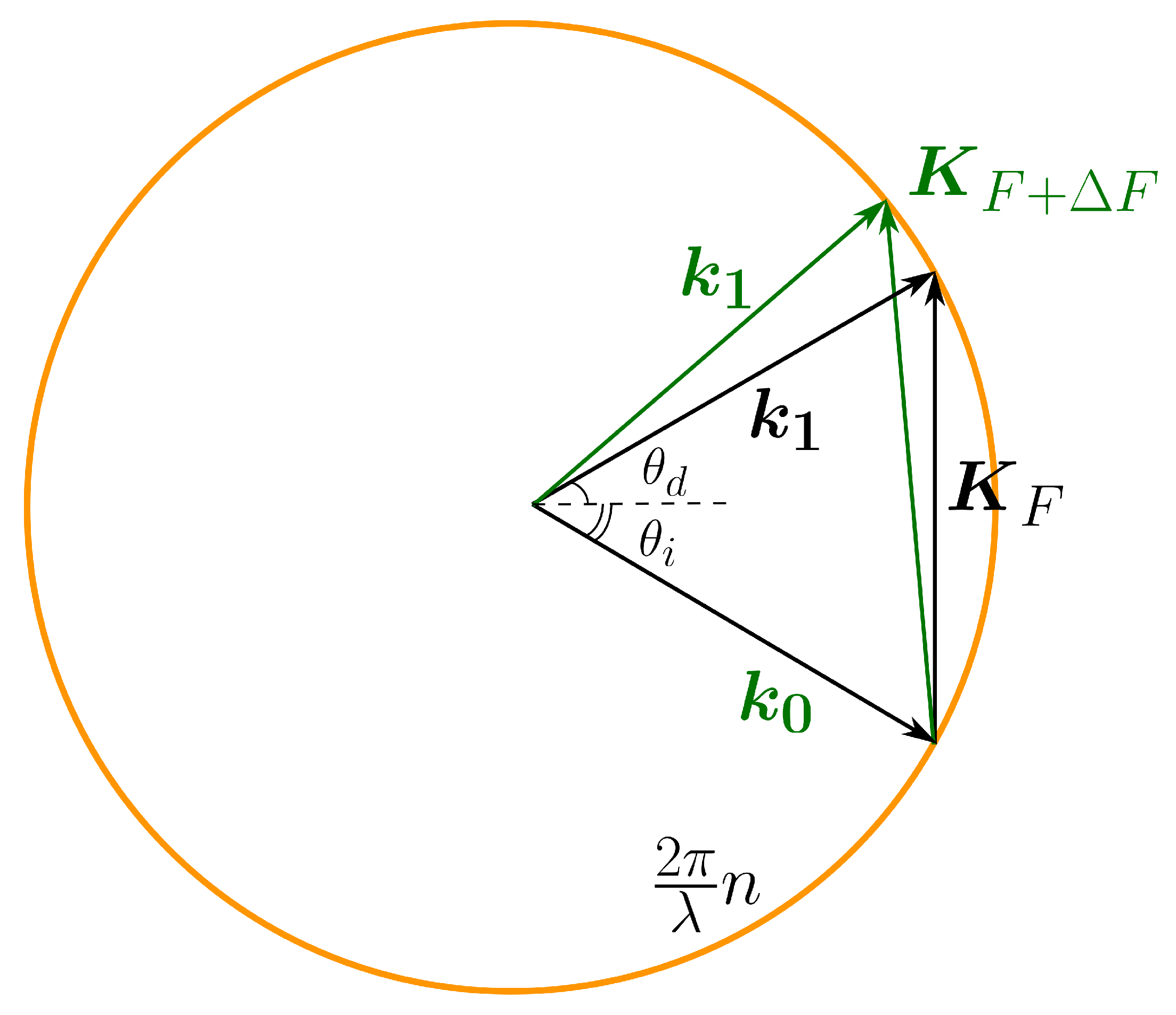
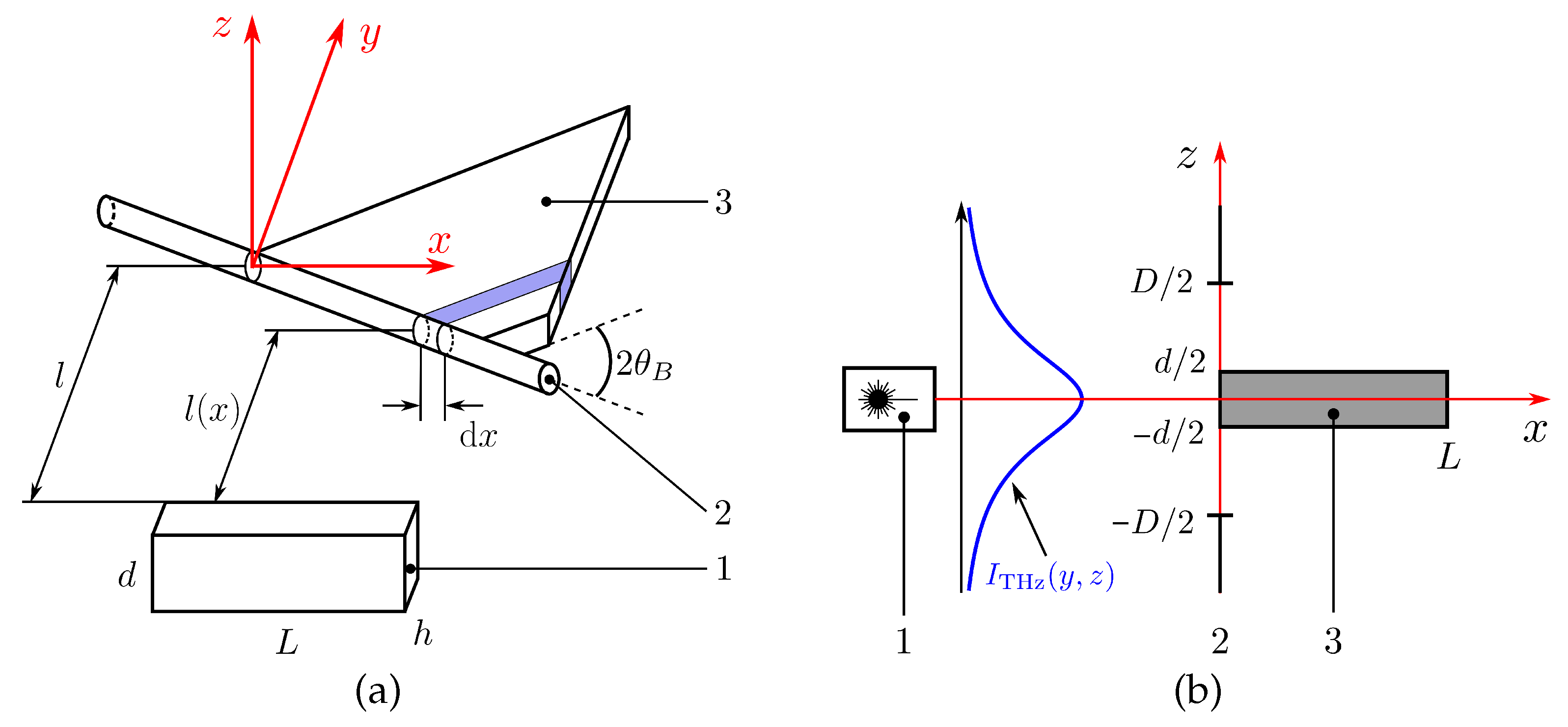
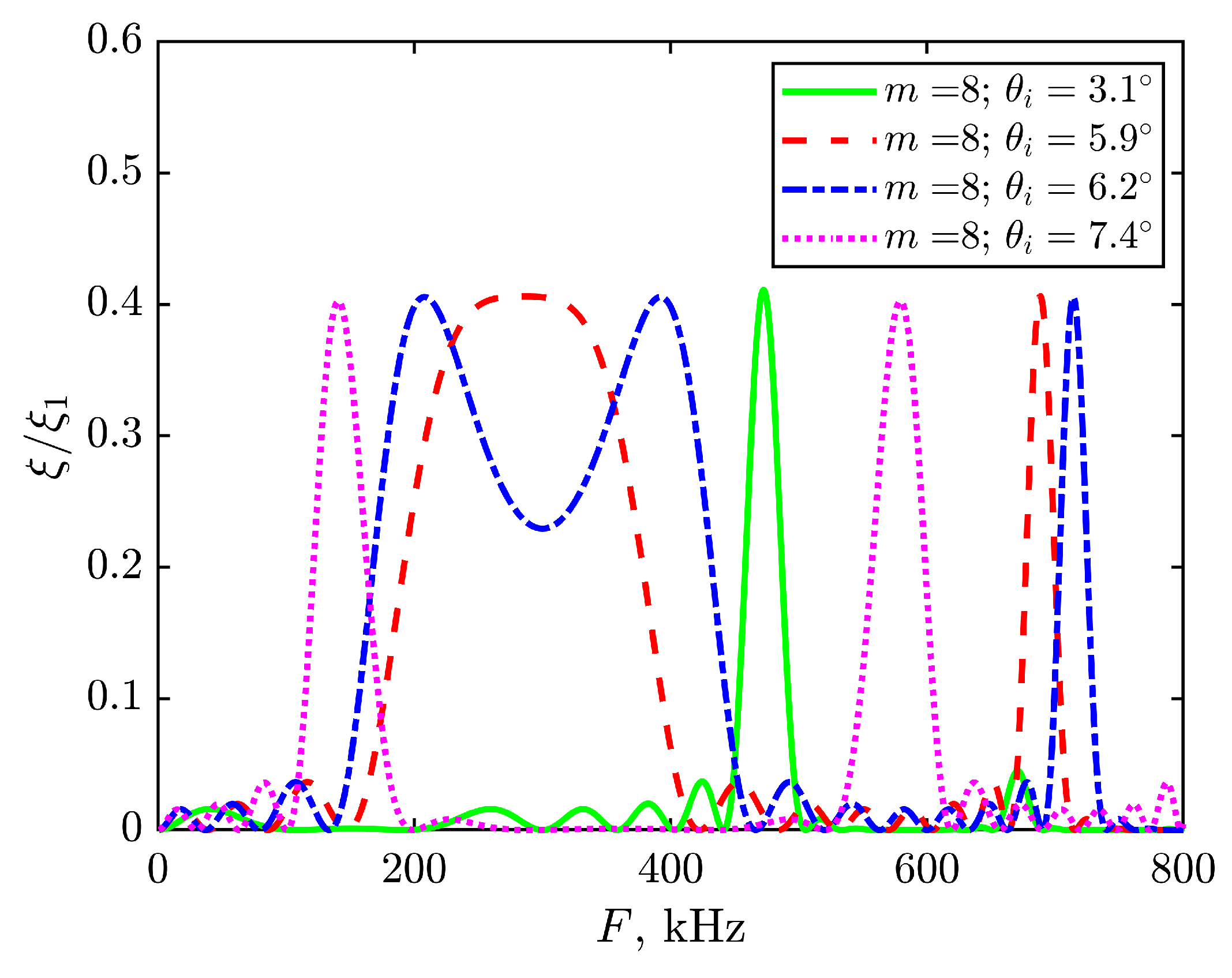

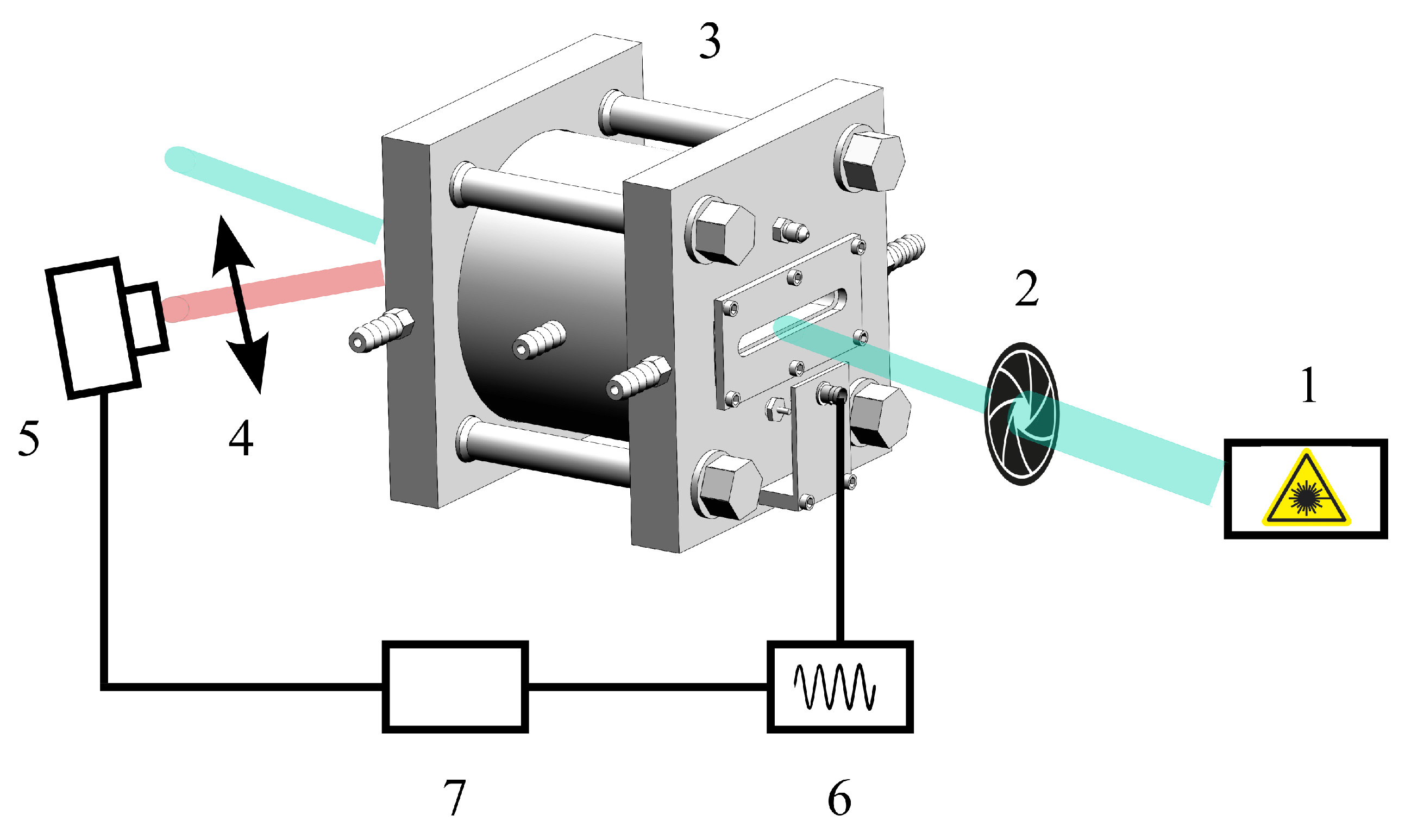
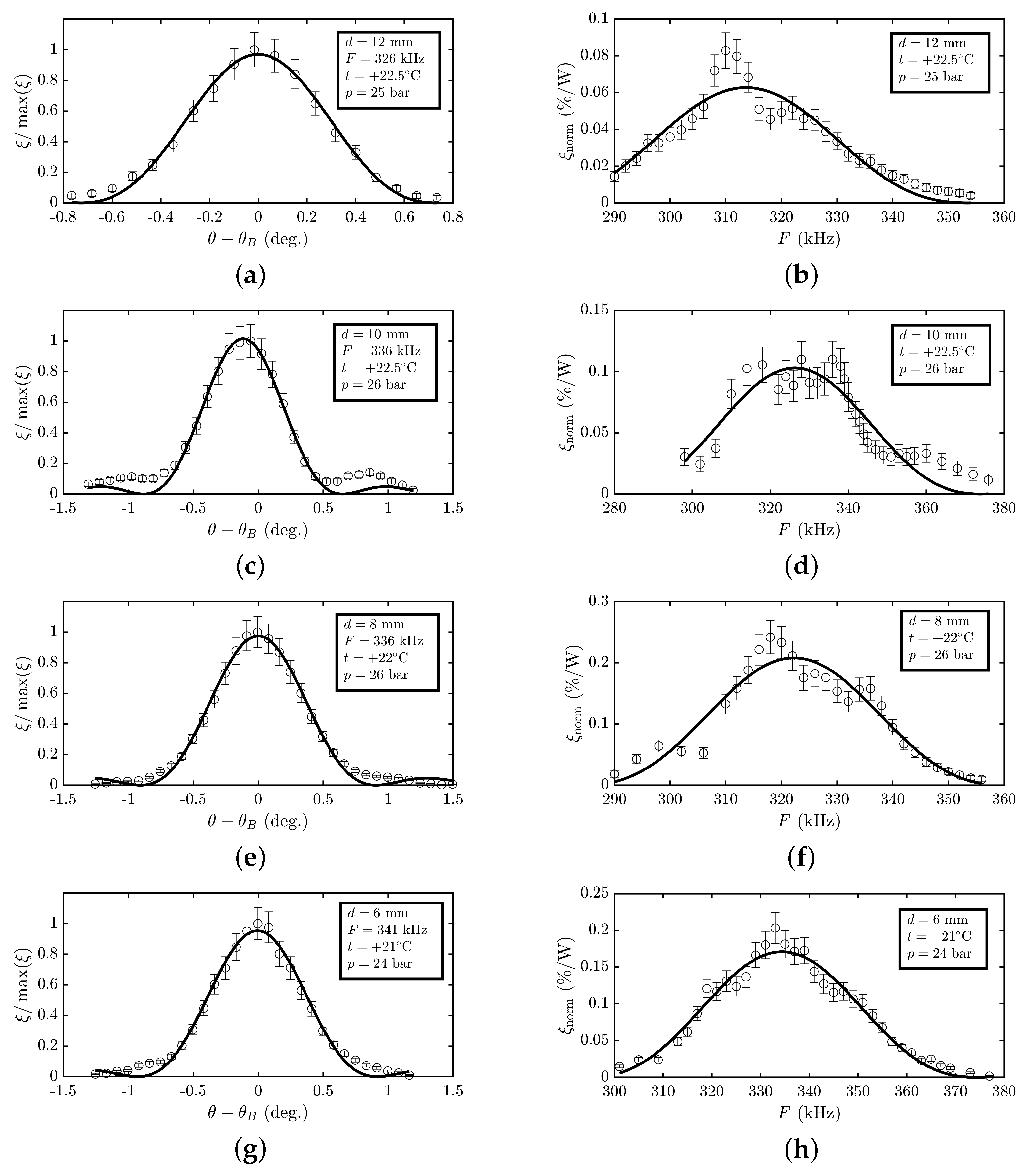
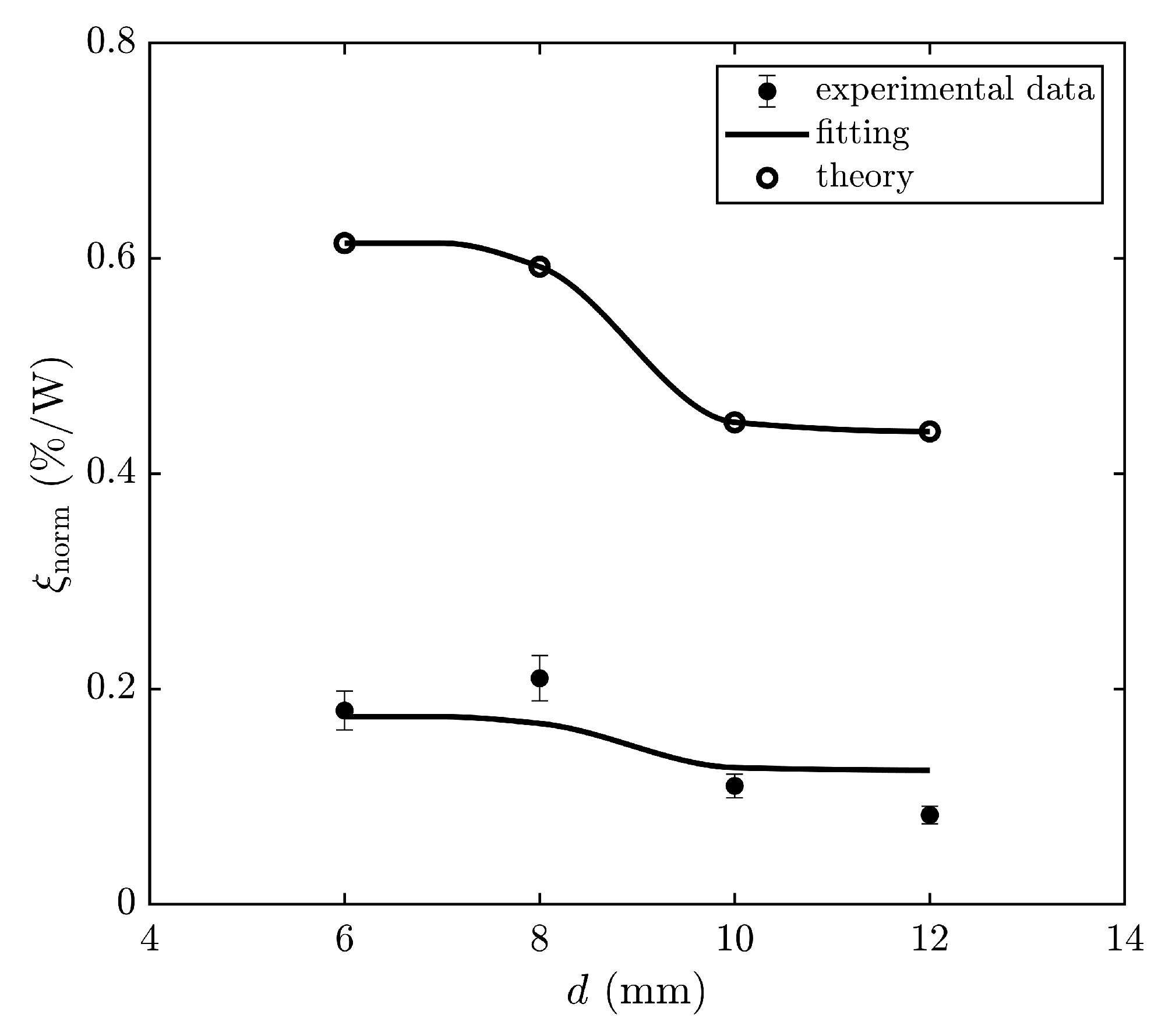
| d (mm) | 14 | 12 | 10 | 8 | 6 | |
|---|---|---|---|---|---|---|
| model | (%/W) | 0.35 | 0.40 | 0.48 | 0.48 | 0.48 |
| fitting | (%/W) | 0.25 | 0.28 | 0.35 | 0.35 | 0.35 |
| experiment | (%/W) | 0.23 | 0.31 | 0.0076 | 0.11 | 0.003 |
| d (mm) | t (°C) | p (bar) | (%/W) | (deg) | (kHz) | (kHz) |
|---|---|---|---|---|---|---|
| 12 | +22.5 | 25 | ||||
| 10 | +22.5 | 26 | ||||
| 8 | +22.0 | 26 | ||||
| 6 | +21.0 | 24 |
Publisher’s Note: MDPI stays neutral with regard to jurisdictional claims in published maps and institutional affiliations. |
© 2022 by the authors. Licensee MDPI, Basel, Switzerland. This article is an open access article distributed under the terms and conditions of the Creative Commons Attribution (CC BY) license (https://creativecommons.org/licenses/by/4.0/).
Share and Cite
Nikitin, P.A.; Gerasimov, V.V.; Khasanov, I.S. Acousto–Optic Modulation and Deflection of Terahertz Radiation. Materials 2022, 15, 8836. https://doi.org/10.3390/ma15248836
Nikitin PA, Gerasimov VV, Khasanov IS. Acousto–Optic Modulation and Deflection of Terahertz Radiation. Materials. 2022; 15(24):8836. https://doi.org/10.3390/ma15248836
Chicago/Turabian StyleNikitin, Pavel Alekseevich, Vasily Valerievich Gerasimov, and Ildus Shevketovich Khasanov. 2022. "Acousto–Optic Modulation and Deflection of Terahertz Radiation" Materials 15, no. 24: 8836. https://doi.org/10.3390/ma15248836
APA StyleNikitin, P. A., Gerasimov, V. V., & Khasanov, I. S. (2022). Acousto–Optic Modulation and Deflection of Terahertz Radiation. Materials, 15(24), 8836. https://doi.org/10.3390/ma15248836







